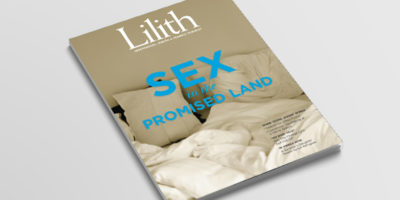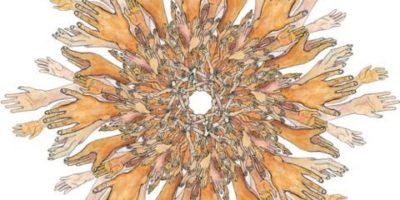
Standing Again at Sinai, Again
By teaching the Jewish world to think about gender, Jewish feminists laid the groundwork for today’s inclusion of transgender Jews.

Joy Ladin. Photo by Joan Roth.
When we think about the achievements of feminism in the US, we usually think about how feminist political activity has changed, and continues to change, the status of women. But in demanding that American Jewish communities and institutions reconsider women’s place and status in them, Jewish feminists have also laid the groundwork for inclusion of transgender Jews by teaching the Jewish world to think about gender.
Marshall McLuhan said that whoever discovered water, you can bet it wasn’t a fish. Before feminism, in most Jewish communities, gender was like water to fish: an invisible, omnipresent medium that permeated every aspect of Jewish identity, from family life to religious practice to social roles to institutional priorities. Jewish families and communities automatically sorted their members by gender, assigning them radically different roles, responsibilities, resources and possibilities; everywhere, Jewish tradition, ritual, liturgy and sacred texts assumed and reinforced the idea that gender divisions were a natural part of Judaism and Jewishness.
American Jewish feminists were fish who discovered water. Though their names and writings were rarely mentioned in the upstate New York Jewish world I grew up in, the work done by Judith Plaskow, Esther Broner, Rivka Haut, Alicia Ostriker and so many others prompted even our backwater congregations to think about gender rather than to assume it, and to recognize that the automatic gendered allocation of roles (the most public, of course, went to men, and the most laborious largely were given to women) was not an inherent, unchangeable aspect of synagogue life, but choices we were making every day. As women in our communities started to question those choices and work toward changing them, everyone, even those defending traditional gender roles, found themselves thinking and talking about gender — and realizing that different members of same community often had very different ideas about what it means to be a Jewish man or a Jewish woman. Feminist theory, queer theory, and gender studies were never mentioned, but as synagogue members debated whether women could be rabbis and presidents, and whether omnipresent male pronouns needed to be changed in prayer books (do we really have to buy new prayer books?) and policy statements (isn’t it clear that “man” means “everyone”?), they were learning that maleness and femaleness and the language and customs that go with them are not fixed by biology or divine decree, but, like so much else in Jewish life, are subject to negotiation.
Thanks to the work of Jewish feminists, Jewish communities across the United States found ideas of gender multiplying like frogs in Pharaoh’s bed. Gender divisions were becoming a source of controversy, disruption, an endless font of inequity and grievance. Many non-Orthodox congregations responded by eliminating gender distinctions in ritual, institutional roles and prayers, creating forms of Judaism and Jewishness that don’t require Jews to be defined as, or to define ourselves, as male or female. (I saw how far we had come when my young son, who grew up with Sheila Peltz Weinberg as his rabbi, asked me one day if men could be rabbis too — a question that demonstrated both how much feminism had changed Judaism, and how hard it is to overcome our tendency to think of Judaism as bound up with and divided by gender.)
Thanks to feminist work, American Jews are now used to thinking about, debating and redefining gender, and developing ways of being Jewish that don’t depend on gender. For transgender Jews — Jews who don’t fit traditional definitions of male and female, either because our gender identities don’t match the sex of our bodies, or because we don’t identify as male or female at all — feminists’ groundbreaking and often back-breaking work is a gift that keeps on giving.
Thanks to feminist defiance of traditional definitions of what it means to be a Jewish woman, Jewish communities wrestling with inclusion of transgender members already know that gender is not just a matter of communal practice, but also of individual self-definition. By insisting that Jewish women need not be bound by traditional feminine gender expression — that women may come to shul in pants as in skirts or dresses, may be carpenters or insurance adjusters or stay-at-home moms, may be gay or bisexual as well as straight — feminists have prepared Jewish communities for members who don’t fit communal ideas of maleness and femaleness.
Similarly, by explaining how alienating it can be for women when male pronouns are presented as universal (“The Jew is a man who…”), a practice that was once the rule in Jewish public speech, feminist thinking has prepared Jewish communities to consider how gendered language sounds and feels to transgender Jews, to understand that language that assumes that everyone is either male or female can inadvertently wound or exclude — and to translate this understanding into thoughtful revisions of liturgy, prayer, and institutional policies. Jewish feminists have shown us what assumptions and practices we need to reconsider, what policies we need to re-examine, and even what committees we need to form, when our communal understanding of gender grows. They have also taught us that in many cases we can avoid hurt feelings and extra committee meetings by eliminating gender distinctions altogether, turning our synagogues and institutions into places that are safe, respectful, equitable and inclusive for everyone, whether we identify as male, as female, or in ways that don’t fit traditional terms at all.
I remember when debates inspired by feminist protest about the roles of women were dismissed as wasteful distractions, irrelevant to and disruptive of the spiritual and religious life of the Jewish people. But Jewish feminists have demonstrated that rethinking gender in Judaism can enrich our understanding of God and Torah. They’ve shown us that conceptualizing God in masculine terms associates God with oppressive patriarchal social systems and misogynist social practices, and thus reflects not God’s nature but human nature, a form of mental idolatry that reduces the incomprehensible mystery of the Divine to narrow human terms. By shattering this idol — by demonstrating that representing God as male is a choice rather than a theological necessity — feminists have prompted liturgists and theologians to recognize and build upon the many other ways Jewish tradition represents God, including images that associate God with femaleness, such as prophetic references to God as “crying out like a woman in childbirth,” and passages that portray God as beyond gender, as the disembodied Source of Creation.
But feminist challenges to the association of God with masculinity have changed more than theology and liturgy. Because Jews believe that human beings are created in the image of God, freeing our conceptions of God from the limits of human gender expands our conception of what it means to be human as well as what it means to be God.
When we insist that God is male, we define women as a lesser form of humanity, in which the image of God is blurrier, less perfectly realized, than it is in men. When we recognize that God, who existed before humanity was a glimmer in God’s eye, who will still be there after the universe itself has vanished, cannot possibly be just male or female, we recognize that everyone created in God’s image is also vaster, more complicated and more mysterious than any gender can encompass. And when we realize that neither God nor humanity fits within the terms of gender, we recognize that being male or female is not essential to being human, an insight that helps us see that transgender people too are created in the image of God.
When Jewish feminists began to challenge the association of God with masculinity, they demonstrated the limitations of all the readings of Torah that depend on that association, and invited all Jews to “stand again at Sinai,” as the title of Judith Plaskow’s ground-breaking book put it: to rethink, reinterpret and reimagine the Torah in new ways. This prompted a flood of readings highlighting the roles of women and the politics of gender in traditional Jewish texts, and inspired an extraordinary outpouring of new midrash, reimaginings of the Torah in story and song, picture and dance, that help us recognize in the Torah a dazzling array of voices, perspectives and possibilities that traditional male-centered readings marginalize, exclude and erase.
The Jewish feminist challenge to stand again at Sinai has empowered transgender Jews to re-read Torah from our own perspectives, to articulate how these ancient texts look to those who, like God, exist beyond the usual categories of male and female, and to highlight aspects of the tradition that speak to transgender experience — like the midrash that imagines that Abraham and Sarah were childless because they were neither male nor female, and that God transformed them sexually so that Sarah could become pregnant — and to create midrash of our own.
As a transgender Jew, I benefit every day from the wisdom, work and courage of Jewish feminists. Without them, the idea of a Jewish world that welcomes all Jews, regardless of gender identity and expression, would seem like a Messianic dream. Thanks to them, in congregations and communities across the U.S., that dream is beginning to come true.
Joy Ladin, Gottesman Professor of English at Yeshiva University, is the author of National Jewish Book Award finalist Through the Door of Life: A Jewish Journey Between Genders. A former Lilith cover girl, she has spoken and published widely on Jewish and transgender identity. www.joyladin.com.



